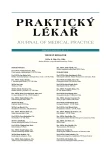Occupational health aspects of manufactured nanomaterials
Authors:
J. Mráz
Authors‘ workplace:
Oddělení pro hodnocení expozice chemickým látkám na pracovištích, Odbor chemických a fyzikálních laboratoří, Státní zdravotní ústav, ředitelka Ing. Jitka Sosnovcová
Published in:
Prakt. Lék. 2011; 91(2): 96-99
Category:
Of different specialties
Overview
While various types od manufactured nanomaterials are increasingly used in advanced technologies and, consequently, also in consumer products, experimental toxicology offers numerous examples of adverse biological effects of these materials. Potentially harmful exposures are likely to occur also in humans, especially in workplaces. The present paper summarizes relevant properties and the use of nanomaterials, occupational monitoring strategies as well as possibilities for preventive workplace interventions.
The public health protection in workplaces with nanomaterials is hindered by the lack of relevant data and tools. In particular,
a) data on the actual exposures in workplaces is usually lacking;
b) knowledge on the adverse effects on human health posed by nanomaterials is very limited;
c) there is no basis for targeted nano-specific occupational medical surveillance;
d) there is no legislation for safe handling of nanomaterials is the workplace.
On the other hand a known latency period of up to several decades to develop certain occupational diseases from chemicals and dusts has to be considered. Thus, the precautionary principle has to be observed by adopting the common protective measures until sufficient data allowing the health risk assessment is available.
Key words:
manufactured nanomaterials, nanoparticles, occupational health, industrial hygiene.
Sources
1. Barabaszová, K. Nanotechnologie a nanomateriály (skripta). VŠB Ostrava: Schenk, 2006. ISBN 80-248-1210-X.
2. European Commission. Presidency conclusions of the high level event „Towards a regulatory framework for nanomaterials´ traceability“, Brussels, 14 September 2010. Dostupné na www.health.belgium.be/filestore/19064475_FR/fr_12129319.pdf.
3. International Organisation for Standardization, ISO/TR 27628: Workplace atmospheres – Ultrafine, nanoparticle and nano-structured aerosols – Inhalation exposure characterization and assessment, Geneva: ISO, 2007.
4. Görner, P., Witschger, O. Rizika v novych technologiach – Nanotechnologie. Bezpečná práca 2009, 40, 6, s. 3-5.
5. Maynard, A. Nanoparticle exposure and occupational lung disease – six expert perspectives on a new clinical study. SAFENANO Community. Dostupný na WWW: http://community.safenano. org/user/Profile.aspx?UserID=2368 Published 18 August 2009.
6. Mráz J. Pasportizace pracovišť s nanomateriály v České republice (Zpráva o plnění úkolu hlavního hygienika ČR). Praha: Státní zdravotní ústav 2008.
7. Nanomedicine. Nanotechnology for Health. 39 s. European Technology Platform, European Commission, Luxembourg 2006. ISBN 92-79-02203-2.
8. Nasterlack, M., Zober, A., Oberlinner, C. Considerations on occupational medical surveillance in employees handling nanoparticles. Int. Arch. Occup. Environ. Health 2008, 81, p. 721-726.
9. Oberdörster, G., Oberdörster, E., Oberdörster, J. Nanotoxicology: An emerging discipline evolving from studies of ultrafine particles. Environ. Health Perspect 2005, 113, p. 823-839.
10. Prnka, T., Shrbená, J., Šperlink, K. Nanotechnologie v České republice 2008. Česká společnost pro nové materiály a technologie. Ostrava: Repronis, 2008. ISBN 978-80-7329-187-7.
11. Prnka, T., Šperlink, K. Bionanotechnologie, nanobiotechnologie, nanomedicína (skripta). Ostrava: Repronis, 2006, ISBN 80-7329-134-7.
12. Schulte, P.A. et al. Options for occupational health surveillance of workers potentially exposed to engineered nanoparticles: State of the Science. J. Occup. Environ. Med. 2008, 50, p. 517-526.
13. Schulte, P.A., Salamanca-Buentello, F. Ethical and scientific issues of nanotechnology in the workplace. Environ. Health Perspect 2007, 115, p. 5-12.
14. Song, Y., Li, X., Du, X. Exposure to nanoparticles is related to pleural effusion, pulmonary fibrosis and granuloma. Eur. Respir. J. 2009, 34, p. 559-567.
Labels
General practitioner for children and adolescents General practitioner for adultsArticle was published in
General Practitioner

2011 Issue 2
- Memantine Eases Daily Life for Patients and Caregivers
- Metamizole vs. Tramadol in Postoperative Analgesia
- Metamizole at a Glance and in Practice – Effective Non-Opioid Analgesic for All Ages
- Memantine in Dementia Therapy – Current Findings and Possible Future Applications
- What Effect Can Be Expected from Limosilactobacillus reuteri in Mucositis and Peri-Implantitis?
Most read in this issue
- Antiaggregation treatment – review of drugs, importance for clinical practice, and possibilities of determination of resistance to treatment
- Autoimmune haemolytic anaemias
-
Basics of social cognitive and affective neuroscience.
II. Empathy - Pulmonary embolism as a paraneoplastic symptom of choroid melanoma
